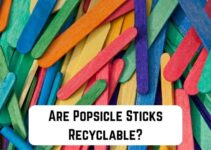We live in an ever-changing and technologically advanced world. A new product will be sold all over the world, requiring shipping. During shipping, unfortunately, if items are not packed well, they will get damaged, and lead to losses. As such, manufacturers had to come up with materials that can protect fragile objects from damage.
Enter packing peanuts, or foam peanuts, which are a common loose-fill packaging and cushioning material, used to prevent damage to fragile objects during shipping. The thing is, once the product has successfully been shipped, these foam peanuts do not have any other work, and can be disposed of. This article will therefore seek to understand the relationship between packing peanuts and the environment.
Can You Recycle Packing Peanuts?
Technically, yes, although it is not that easy.
Packing peanuts enter our homes through the purchases we make, and they are meant to protect items during shipping or transfer. The problem is they are an expanded and air-filled polystyrene.
Polystyrene or Styrofoam is a plastic polymer, meaning it cannot be recycled as it does not break down easily even at the recycling plant and there are very limited uses to make new products from polystyrene.
Also, packing peanuts cause a problem at recycling since they are 95% air, all volume and no weight. The problem is they will blow away with the wind and take up a lot of space.
As recycling is not an option, most people tend to reuse them or give them back or away. Some may return the packing peanuts to the company that sent them the package and the peanuts, who can reuse them for another customer, saving money in the process.
Others donate them to shipping companies for use with packing another customer’s order or to friends who might need them when moving. Others get creative with them and end up reusing them at home. You can put them in the bottom of a planter, pin them with your keys helping the keys stay afloat, and make pillows or cushions.
Out of the packing peanuts, you can also make Halloween costumes, decorate your Christmas tree with the peanuts, make a craft project especially with your children, or even insulate cooers or lunchboxes.
It is however important to note that there is a company in Tennessee that disposes of Styrofoam by putting it in a machine called a densifier. The machine changes the material’s chemical composition and breaks it down. This means although the material is harmful to the environment, there are chances of recycling it.
In fact, the company invites all local businesses to bring down a piece of Styrofoam or un-recyclable plastic and shows them how they can divert it away from a harmful landfill. There is also a study that concluded that meal-worms could survive on a diet of Styrofoam plastic, making it one of the most innovative ways of getting rid of the unrecyclable material.
Finally, the market for Styrofoam is diminishing, meaning even if it can be recycled in the minimal locations known, it will be of no use going forward.
Are Packing Peanuts Biodegradable?
Traditional packing peanuts are not biodegradable, although the newer versions are.
Traditional packing peanuts, which were made commercially available in the mid-1960s by Dow Chemicals, were or are made from polystyrene, as mentioned above. They are labeled as #6 plastic and can make, among others, consumer products like toys, jewel cases and dishware. When you inject air into the #6 plastic, you come up with expanded polystyrene (EPS).
Most packing peanuts are made of EPS, more commonly known by the brand name Styrofoam, which are up to 98% air. EPS is plastic, making it non-biodegradable and obviously non-recyclable. As such, they end up littering the roadsides for years and can sit in landfills for hundreds of years.
To combat this, in the early-1990s, a biodegradable alternative to EPS packing peanuts was found; starch-based packing peanuts. These are a new introduction to the market and are eco-friendly. They are made from corn-starch, although some companies use sorghum, a grain used in molasses, animal food and occasionally, human food.
The result is a starch-based packing peanut that looks and functions just like the polystyrene one but will biodegrade over time. Unfortunately, they tend to be more expensive than the polystyrene variety, but are at least safer for the environment.
They are also less resilient, have a higher weight, create dust, and can potentially attract rodents. Luckily, the starch-based peanuts are soluble in water and can therefore be disposed of down the sink as they will dissolve on contact with water.
How Long Does It Take for Packing Peanuts to Decompose?
Depends on the type of material used to make the packing peanuts
Of course, the polystyrene variety does not decompose and can take hundreds of years before breaking down. Some experts estimate the decomposition of Styrofoam to 500 years, and that period could be longer. There are limited recycling options, although reusing is a remaining option.
However, all other means of eliminating these packing peanuts, that do not involve reusing, are hazardous to the environment. If sending them to landfills is the only way out, it will take centuries before the polystyrene packing peanuts break down completely.
The biodegradable starch-based alternatives have been built to biodegrade with time, resulting in less damage to the environment. As already mentioned, they are soluble in water, meaning they can dissolve in water immediately on contact.
They can also break down within minutes of contact with moisture if they are placed on the ground. They dissolve in most types of liquid and leave no waste behind. If ingested by animals or sea life, they pose no major health threat because they are made using non-toxic materials
Are Packing Peanuts Compostable?
Yes, and No!
The Styrofoam variety is harmful to the environment and even attempting to compost it will transfer the harm to your garden. Even before getting there, it cannot be composted because it brings no value to the composting pile.
It takes hundreds of years to decompose fully, meaning it will not break down in the compost pile. The packing peanuts are largely air and even if they decomposed in your compost, they will add nothing but the air to your pile.
The starch-based biodegradable packing peanuts, on the other hand, can be composted. They are bio-peanuts, made from natural and plant-based starches, meaning they will release the starch into the compost pile. However, remember they dissolve within minutes once exposed to moisture and warmth. As such, for people in relatively cold or wet climates, composting will not be an option for them.
However, they can be composted if you live in a warmer climate. Therefore, if you have decided to compost the starch-based packing peanuts, remember they will only be relied upon to break down in a composting environment with additional assistance. Either way, they degrade without a trace and do not leave behind a toxic residue.
Are Packing Peanuts Bad for The Environment?
The biodegradable kind is safe for the environment, although the traditional, non-biodegradable kind is very bad for the environment. The process of making the former requires less energy and the facilities that manufacture these packing peanuts emit fewer greenhouse gases. They are also safer to manufacture.
For the polystyrene packing peanuts, the problems start from the manufacturing process and do not end even after disposal. First, they harm human health by irritating the skin, eyes, and upper respiratory tract as well as causing gastrointestinal effects.
Secondly, Styrofoam which makes these packing peanuts is a collection of harmful chemicals, which can leech into food, affecting human health and reproductive systems.
Thirdly, and particularly on the environment, Styrofoam takes about 500 years to decompose and the recycling programs are pretty much non-existent. It is also resistant to photolysis, which is the breaking down of materials by photons originating from light.
This, combined with the fact that Styrofoam floats, means that large amounts of polystyrene have and will continue to accumulate along coastlines and waterways around the world. Such marine debris affects marine life and pollutes ocean waters
Fourthly, polystyrene packing peanuts contribute to air pollution. According to the National Bureau of Standards Centre for Fire Research, there are 57 chemical by-products released during the creation of Styrofoam, which might also translate to the same number of chemicals released if the packing peanuts are incinerated. The manufacture of these polystyrene peanuts relies on the use of hydrofluorocarbons (HFCs), which harm the environment, specifically contributing to climate change.
Fifthly, if sent to landfills, these products are full of chemicals that will continue to poison the soul and surrounding bodies of water. Finally, they are made from petroleum, which is a non-sustainable resource, the production of which creates heavy pollution and accelerates climate change.
How Do You Dispose of Packing Peanuts?
The biodegradable starch-based packing peanuts can simply be dissolved in water and they will be gone without any trace. At the same time, how do you determine polystyrene peanuts and distinguish them from starch-based ones? First, use your eyes.
The white or pink peanuts are most likely made from polystyrene. The biodegradable kind tends to be green in color, for ease when distinguishing them from their foam counterparts. Secondly, try building static electricity from them and stick them to your clothes. The biodegradable kind will not get sticky but the polystyrene ones will stick to clothes.
Finally, do a water test and drop them in a glass of warm water. If it dissolves, you had the biodegradable ones and dissolving them all in the water is safe. If they don’t, you have the foam ones.
Unfortunately, all disposal avenues for polystyrene packing peanuts affect the environment. However, check to see if there are companies that might accept them, reuse them for packaging or simply reuse them for other means.
Many drop-off sites will only accept white packing peanuts, so you’ll want to separate out any other colors. You can also bag them safely so that they do not escape and become litter when being transported.
You can also contact schools and churches to see if they can be donated for reuse in art projects. Some EPS recyclers accept these peanuts, although recycling will be a secondary option for them. Simply contact them and confirm if they have a minimum quantity accepted for recycling.
If the disposal is not an option, you can also simply reuse the packaging peanuts at home. You can keep them in your house and store them for reuse when shipping gifts for the holidays or birthdays.
There is no reason to pay for new packing peanuts if you have an abundance of used ones. Also, remember you might decide to shift to another house, and you might need the packing peanuts for your delicate belongings.






